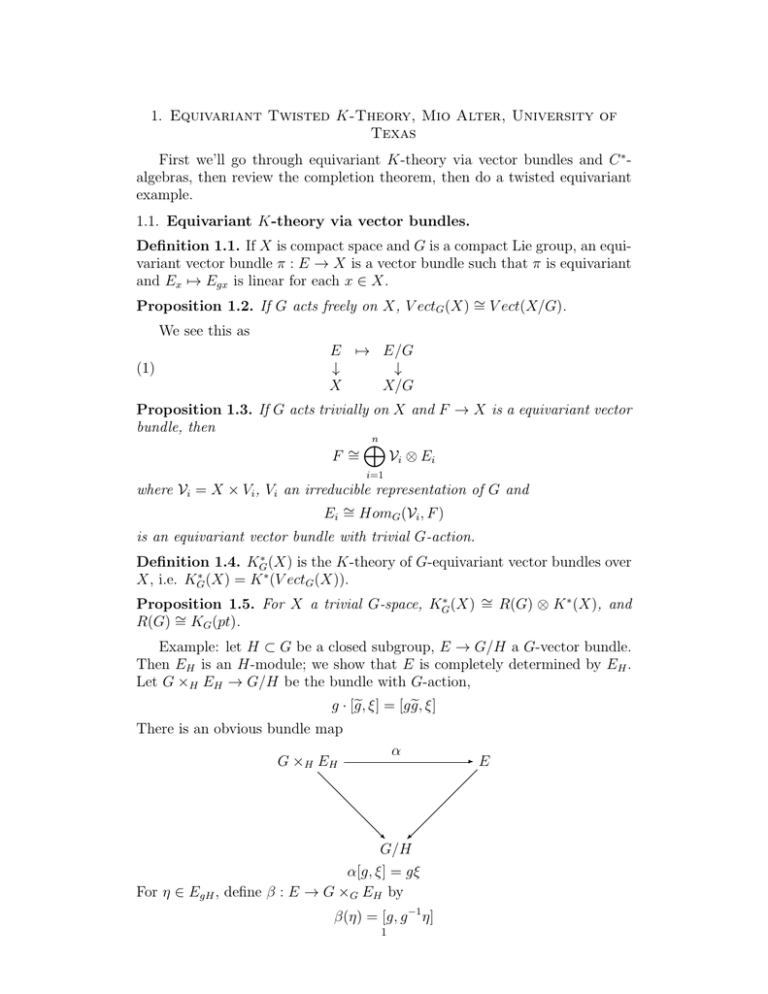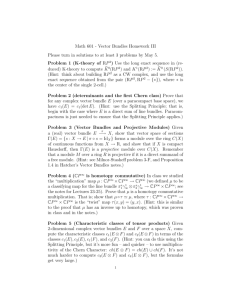1. Equivariant Twisted K-Theory, Mio Alter, University of Texas
advertisement

1. Equivariant Twisted K-Theory, Mio Alter, University of
Texas
First we’ll go through equivariant K-theory via vector bundles and C ∗ algebras, then review the completion theorem, then do a twisted equivariant
example.
1.1. Equivariant K-theory via vector bundles.
Definition 1.1. If X is compact space and G is a compact Lie group, an equivariant vector bundle π : E → X is a vector bundle such that π is equivariant
and Ex 7→ Egx is linear for each x ∈ X.
Proposition 1.2. If G acts freely on X, V ectG (X) ∼
= V ect(X/G).
We see this as
(1)
E 7→ E/G
↓
↓
X
X/G
Proposition 1.3. If G acts trivially on X and F → X is a equivariant vector
bundle, then
n
M
F ∼
Vi ⊗ Ei
=
i=1
where Vi = X × Vi , Vi an irreducible representation of G and
Ei ∼
= HomG (Vi , F )
is an equivariant vector bundle with trivial G-action.
Definition 1.4. KG∗ (X) is the K-theory of G-equivariant vector bundles over
X, i.e. KG∗ (X) = K ∗ (V ectG (X)).
Proposition 1.5. For X a trivial G-space, KG∗ (X) ∼
= R(G) ⊗ K ∗ (X), and
R(G) ∼
= KG (pt).
Example: let H ⊂ G be a closed subgroup, E → G/H a G-vector bundle.
Then EH is an H-module; we show that E is completely determined by EH .
Let G ×H EH → G/H be the bundle with G-action,
g · [e
g , ξ] = [ge
g , ξ]
There is an obvious bundle map
α
G ×H EH
-
-
G/H
α[g, ξ] = gξ
For η ∈ EgH , define β : E → G ×G EH by
β(η) = [g, g −1 η]
1
E
2
It is clear that if we choose a different coset representative, we get the same
thing, so β is well-defined. It is immediate that β is a 2-sided inverse to α so
E∼
= G ×H EH
Thus, the category of G-vector bundles on G/H is equivalent to the category
of H-modules,
V ectG (G/H) ∼
= V ectH (pt)
It follows that
KG∗ (G/H)
=
∗
(pt)
KH
=
R(H) ∗ = 0
0
∗=1
Remark: There is a localization theorem for equivariant K-theory which
is analogous to the localization theorem for equivariant cohomology.
One might also start with the Borel construction for equivariant K-theory
and take the equivariant K-theory of a space to be just the ordinary K-theory
of the Borel quotient
XG ∼
= EG ×G X.
However, the equivariant bundle picture is much richer. In fact,
Theorem 1.6 (Atiyah-Segal Completion).
∼
=
∗
∗
K\
G (X)I → K (XG ).
where I is the augmentation ideal (the kernel of the augmentation map :
R(G) → Z given by evaluating at 1 ∈ G), that is, the ideal generated by
virtual representations of virtual dimension zero.
1.2. Equivariant K-theory via C ∗ -algebras. Recall that a C ∗ -algebra is a
Banach algebra with a C-linear involution. All C ∗ -algebras have embeddings
into B(H) for some Hilbert space H. An example of a C ∗ -algebra is the ring
of continuous functions C(X, C), where X is a compact space.
Definition 1.7. For G a compact Lie group and A a C ∗ -algebra, a continuous
action of G on A is a map α : G → Aut(A) where for a sequence gn → g,
α(gn )(a) → α(g)(a) for all a ∈ A.
Definition 1.8. A (G, A, α)-module is an A-module in which G acts compatibly with the A-action.
Definition 1.9. K0G (A) is the Groethendieck group of isomorphism classes of
projective (G, A, α)-modules.
Definition 1.10. The crossed product G ×α A is a completion of the twisted
C ∗ -algebra, C(G) ⊗ A where the product (convolution) and involution are
defined in terms of α.
Theorem 1.11. K0G (A) ∼
= K0 (G ×α A)
3
Comment: so for C ∗ -algebras, unlike for spaces as seen by the Completion
theorem, the equivariant K-theory of a G-algebra is the ordinary K-theory of
an associated ordinary algebra.
Also, note that if your C ∗ -algebra happens to be the algebra of functions
on a compact Hausdorff space X, the (equivariant) K-theory of the space
agrees with the (equivariant) K-theory of the C ∗ -algebra,
KG∗ (X) ∼
= K∗G (C(X))
1.3. Atiyah-Segal Construction of Twisted Equivariant K-Theory.
Proposition 1.12. Classes in H 3 (X; Z) are in bijection with projective Hilbert
bundles P → X up to isomorphism.
Proof. To go from a bundle to a class, consider a cover of X on which Pα ∼
=
P(Eα ), Eα a Hilbert bundle over Uα . Then there are transition functions
gαβ : Pα → Pβ ,
which we can lift to
g̃αβ : Eα → Eβ ,
but there is a cocycle condition on these, namely
g̃αβ g̃βγ g̃γα : Xαβγ → U (1),
and this defines a class η ∈ H 2 (X; U (1)) ∼
= H 3 (X; Z) where the isomorphism
follows from the exponential sequence of sheaves 0 → sh(Z) → sh(R) →
sh(U (1)) → 0 of continuous Z, R, and U (1)-valued functions and H i (X; sh(R)) =
0 for i > 0 since sh(R) has partitions of unity.
Less concretely (but for a quick proof of both directions in the theorem)
P U (H) is a K(Z, 2), so BP U (H) is a K(Z, 3), and then we have that
H 3 (X; Z) ∼
= [X, BP U (H)],
which in turn is projective Hilbert bundles, up to isomorphism. Now given τ ∈ H 3 (X; Z) Let τ P → X be the corresponding projective
Hilbert bundle. Let F red(τ P) → X be the associated bundle with fiber
F red(H). Similarly let τ K → X be the associated bundle with fiber compact operators on H.
Now we define twisted K-theory as
τ
τ
K 0 (X) ∼
= π0 (Γ(X; F red(τ P)))
e 0 (Γ(X; τ K ⊕ I · C))
K 0 (X) ∼
=K
where these are sections that are a compact operator plus the identity.
We remark that the automorphisms of these projective Hilbert bundles
come from tensoring with a line bundle.
4
1.4. Twisted Equivariant Story.
Theorem 1.13 (Atiyah-Segal). There is a bijection between G-equivariant
projective Hilbert bundles over X and projective Hilbert bundles over XG , the
homotopy quotient.
So G-equivariant twists are in bijection with HG3 (X; Z).
Then we define
τ
KG0 (X) := π0 (Γ(X; F red(τ P)))
e 0 of the category of continuous projective
We can also take as our definition K
τ
(G, Γ(X; K ⊕ I · C))-modules. This is also equal to
e 0 (G ×α Γ(X; τ K ⊕ I · C)).
K
1.5. A Computation. H 1 (X; {G−Line Bundles}) ∼
= HG1 (X; {Line Bundles}) ∼
=
3
HG (X; Z)
Let’s consider the example where X = U (1) acts on itself by conjugation (i.e. trivially); we still get interesting vector bundles, since the fibers
are representations of U (1). Take the open cover U = U (1) \ {1} and V =
U (1) \ {−1}, let L be the defining representation of U (1) and fix a twisting
τ ∈ HU3 (1) (U (1), Z) ∼
= Z corresponding to n under this isomorphism. A representative of the Cech 1-cocycle corresponding to this twist is the equivariant
line bundle Ln on U ∩ V + and 1 on U ∩ V − .
We have the Mayer-Vietoris sequence
τ
KU0 (1) (U (1)) →
↑ T
(2)
τ
1
KU (1) (U V ) ←
but
τ
τ
KU0 (1) (U ) ⊕ τ KU0 (1) (V ) →
τ
KU1 (1) (U ) ⊕ τ KU1 (1) (V ) ←
τ
KU0 (1) (U ∩ V )
↓
τ
1
KU (1) (U (1))
KU1 (1) (U ) ∼
= τ KU1 (1) (pt) = 0,
so we get a sequence
0 → τ KU0 (1) (U (1)) → Z[L± ]2 → Z[L± ]2 → τ KU1 (1) (U ) → 0.
where the middle map is given by (x, y) 7→ (x − y, x − y n ) since restriction
from U is straight restriction, but when we restrict from V , we tensor with
the line bundle on the intersection. This shows
τ
K 1 (U (1)) ∼
= Z[L± ]/ < 1 − Ln >,
U (1)
and 0 otherwise.
Remark: when we add C·I in the above, we need to take reduced K-theory.
It’s like adding a disjoint basepoint.





